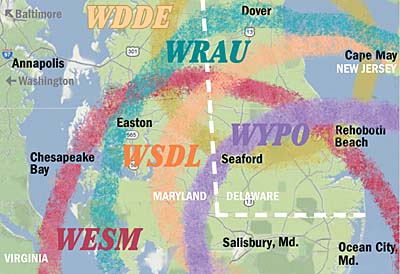‘Status quo’ no longer feasible for Delmarva’s local stations

For 25 years, Delmarva Public Radio in Salisbury, Md., had the public radio news market in its broadcast area largely to itself. But competition from repeater stations of WYPR in Baltimore and WAMU in Washington, D.C., and the funding constraints they brought have prompted its university licensee to consider getting out of the NPR news game.
An analysis prepared by Public Radio Capital recommends that the Salisbury University Foundation negotiate a deal with another pubcaster to operate its two Delmarva Public Radio outlets as music stations, dropping the NPR News format now airing on WSDL 90.7 FM in Ocean City, Md., and continuing an all-classical service on WSCL 89.5 FM in Salisbury.
The foundation, an affiliate of Salisbury University, has been covering financial losses at the stations for three of the last four fiscal years — most notably a 2008 deficit of more than $150,000 — and faces increased capital expenses in relocating the stations’ studios from a university building that’s set to be demolished.
The Delmarva stations closed fiscal year 2010 in the black with about $25,000 in net income, but the overall financial picture prompted the foundation to commission a study from Public Radio Capital, the Colorado-based consultancy specializing in public radio signal expansion and preservation.
“The status quo just hasn’t worked and won’t work anymore,” said Dennis Hamilton, PRC director of consulting and author of the report.
If the foundation continues to operate the stations as it is now — the so-called “status quo” scenario examined in the report—its operating deficits could reach $240,000 a year by 2022. Hamilton examined several other options, including operating both as classical stations or selling them to another nonprofit, and recommended entering into a public service operating agreement (PSOA) that involves converting WSDL into a Triple A music service and eliminating all local news coverage.
Entering into a PSOA would allow the foundation to retain ownership of the signals but would eventually end the stations’ reliance on university subsidies. The switch to adult alternative music programming would reduce the cost of operating WSDL while introducing an unduplicated public radio format to the region. For classical WSCL, PRC recommends picking up Classical 24, the syndicated programming stream produced by American Public Media and distributed by Public Radio International.
“I think it’s a great opportunity for them to recalibrate the market and offer better service,” Hamilton said. “It’s a smart thing for media operators to do — make sure they’re doing the best they can to serve the audience.”
But some local fans of the station disagree, and they began criticizing the study once the local press reported news of its existence. DPR listeners and supporters took up a letter-writing campaign to the Salisbury Daily Times, calling on the foundation to keep the stations intact and retain local news.
“Following this recommendation would be the death of local content for the area and is very bad news for WSCL and WSDL,” said Tom Hehman, a station volunteer and member of Friends of Delmarva Public Radio, a group with some 174 Facebook followers who want to mount a local bid to operate the stations. “I think we owe it to ourselves after 25 years to give the community a chance to save these stations.”
Hehman, a retired head of the county’s public library system, described the analysis as “flawed” and self-serving because PRC recommends that the foundation hire a third party to broker a deal, a role that it offered to fill.
Can all boats rise at shore?
According to Arbitron’s fall 2012 survey, Salisbury/Ocean City is the 140th largest market in the U.S. with a 12-plus listening population of 329,700. Ocean City is one of Maryland’s most popular ocean side resorts, and during the summer its population explodes into the hundreds of thousands.
Delmarva’s classical WSCL received its license in 1986, the same year that WESM 91.3 FM, a jazz and NPR news station owned by the University of Maryland Eastern Shore, went on the air in Princess Anne. Until 1997, when the Salisbury University Foundation launched WSDL as an NPR news service, the two universities were the only institutions providing public radio programming to the region.
That began to change in 2007 when WYPR brought its signal to the Delmarva Peninsula, followed by WAMU in 2010. The addition of two big-city stations gave listeners five options for NPR News and talk programming.
WAMU hired a reporter to cover local news and produce Coastal Connection, WRAU’s weekly interview and news show, and it’s looking to beef up its local output even more, according to Mark McDonald, WAMU p.d. He’s open to discussing proposals for a PSOA and said that despite the competition in the market, there’s still room for the stations to air distinctive programming.
“I hope that with this, all boats would rise and we would be able to work together on it,” McDonald said. “We’d always consider anything that would benefit us with local content, because like all public radio stations, we stand or fall on how much local content we can put in the mix.”
Boon for listeners?
Under the PSOA proposal, the Delmarva stations would stop offering news because they’ve lost too much ground to WAMU’s new outlet.
“As for the argument that this option guts local coverage, it’s already been gutted,” Hamilton said. “WAMU’s coming into the market disrupted the business model. The stations aren’t making money, and there is no money to make it bigger.”
Under a PSOA, the foundation would save nearly $1 million, by Hamilton’s estimate. Anticipated subsidies for operating WSDL and WSCL would drop from $1.1 million in FY2013 to $104,000 in FY2014. Savings would come from the “elimination of program acquisition, cuts in station staff, downsizing the need for studio and office space, and reductions/eliminations of various other expenses.”
Staffing could be reduced to a “licensee staff person” and any new hires that the stations’ new operator chooses to make, according to the report. News programming and a newsroom of journalists producing local coverage would no longer be necessary.
Gerry Weston, a former g.m. of Delmarva Public Radio who now runs WICN-FM in Worcester, Mass., expressed hope that some local news could be preserved under the PSOA.
“I understand the difficulty of running those two stations, because I was there, but I am saddened they’re losing local news content,” Weston said. “We had a great news organization in Salisbury, and I’ll be sorry to see it go.”
There’s a track record of success behind PRC’s recommendations for the Delmarva stations, Hamilton said, pointing to markets such as Minneapolis where two stations aired classical music until the introduction of a Triple A music station, Minnesota Public Radio’s The Current. He said the Triple A format would “get traction” in the Eastern Shore region and give public radio fans a new choice.
Others questioned the recommendation to completely eliminate local content. WSDL could make money as a Triple A station, said John Sutton, a Maryland-based public radio marketing consultant, but it will have a better shot at building a loyal listenership if it produces local news content. “The stations will do well, but they won’t be blockbusters,” Sutton said. “It’s a case with those formats where localization can make a big difference.”
If the foundation opts to follow PRC’s recommendations, its next step would be to hire a third party, possibly PRC, to facilitate the PSOA. But before making any decisions, foundation officials will convene a meeting Oct. 16 to hear public comments on the report’s recommendations.








WYPR’s Ocean City repeater started operating in 2007… several years before WAMU’s repeater did (in 2010, as the story correctly states).
I would be sad to see local programming gone on WSCL and WSDL. Public Radio Capital stands to profit greatly from being involved in a lease of these stations, therefore they are biased and their analysis cannot be trusted.
PRC was also involved in the destruction of the great KUSF in San Francisco, and its transformation from a 100% locally-programmed world-class college radio station with significant community input into a classical repeater with no local content.
Also, the coverage of WYPO as suggested by the map in this article is incorrect. WYPO barely reaches Salisbury, and has a poor signal in some parts of Salisbury. Perhaps its transmitter needs some work. Under 106.9’s previous owners, its signal is Salisbury was also spotty.
It’s a little disturbing how unbalanced this coverage is in favor of the PRC. It is pretty well known in the PubRad world that PRC has a rep of killing local broadcasting in favor of pre-fab. This also doesn’t address the issue of classical music broadcasting in general being marginalized and ghettoized within PubBroad. Classical music has been written off as “dying” for 200 years. It’s still here and going steady. The audience isn’t aging and dying, on the contrary, young audiences who listen to other music usually mature INTO classical listening. How about doing a follow up article that is more balanced?
Up to this point, CPB has sanctioned the predatory actions of large market
public stations from Baltimore, DC and Norfolk, barging in on small market
public stations on Delmarva. Not only is that sad, it is wishy-washy policy which leaves CPB open to massive political attacks on Capitol Hill. CPB
has mud on its’ face because if it weren’t for CPB funding since 1987, WESM, WSCL, and WSDL wouldn’t exist. Now, CPB appears to be treating the Delmarva stations like bastard children in a 1950’s American framework; before the Public Broadcasting Act of 1967.
While the self-appointed “saviors” of public radio at PRC would not want you to think of this battle in a different way, put aside the pros and cons of formats for a second. There is something terribly wrong going on here, regardless of whether the stations affected in Salisbury and Princes Anne are playing Mozart, Monk, NPR-type news programming, World Café fare, or (heaven forbid) something new and innovative. This problem has to do more with the importance of bolstering small market public stations to serve, in nothing else, as an incubator for the entire public radio system, where training of new talent and new programming ideas can have time to develop and even flourish. It is an idea countered by the extreme audience-building mindset, and take-over or merger mania spreading like cancer in the public radio system. It has to be addressed, or the entire system will die from homogeneity.
CPB can do something. It can require WAMU, WHRO, and other major market players on Delmarva to pay a steep percentage of the revenue it raises on Delmarva to the stations that are based there. That is the only way that locally
generated public radio on Delmarva will survive, period. CPB can enact such fairness, but up to this point it doesn’t seem like CPB is in the mood.
It needs to grow a pair.